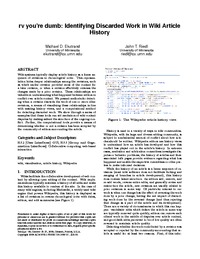rv you're dumbIdentifying Discarded Work in Wiki Article History
Michael D. Ekstrand, John Riedl
Zu finden in: WikiSym 2009, 2009
|
 |
 Diese Seite wurde seit 6 Jahren inhaltlich nicht mehr aktualisiert.
Unter Umständen ist sie nicht mehr aktuell.
Diese Seite wurde seit 6 Jahren inhaltlich nicht mehr aktualisiert.
Unter Umständen ist sie nicht mehr aktuell.
 Zusammenfassungen
Zusammenfassungen
Wiki systems typically display article history as a linear sequence of revisions in chronological order. This representation hides deeper relationships among the revisions, such as which earlier revision provided most of the content for a later revision, or when a revision effectively reverses the changes made by a prior revision. These relationships are valuable in understanding what happened between editors in conflict over article content. We present methods for detecting when a revision discards the work of one or more other revisions, a means of visualizing these relationships in-line with existing history views, and a computational method for detecting discarded work. We show through a series of examples that these tools can aid mediators of wiki content disputes by making salient the structure of the ongoing conflict. Further, the computational tools provide a means of determining whether or not a revision has been accepted by the community of editors surrounding the article.
Von Michael D. Ekstrand, John Riedl im Konferenz-Band WikiSym 2009 (2009) im Text rv you're dumb  Dieses Konferenz-Paper erwähnt ...
Dieses Konferenz-Paper erwähnt ...
 Begriffe KB IB clear | CommunityCommunity
,  Kollaboratives Schreiben Kollaboratives Schreiben collaborative writing
, Schreibenwriting
, collaborative writing
, Schreibenwriting
,  Struktur Struktur structure
, Versionsverwaltungrevision control
, Wikiwiki structure
, Versionsverwaltungrevision control
, Wikiwiki
|
 Dieses Konferenz-Paper erwähnt vermutlich nicht ...
Dieses Konferenz-Paper erwähnt vermutlich nicht ... 
 Nicht erwähnte Begriffe | Wiki in education |
 Tagcloud
Tagcloud
 Volltext dieses Dokuments
Volltext dieses Dokuments
 |  rv you're dumb: Artikel als Volltext ( rv you're dumb: Artikel als Volltext ( : :  , 629 kByte; , 629 kByte;  : :  Link unterbrochen? Letzte Überprüfung: 2021-03-21 Letzte erfolgreiche Überprüfung: 2019-02-28) Link unterbrochen? Letzte Überprüfung: 2021-03-21 Letzte erfolgreiche Überprüfung: 2019-02-28) |
 Anderswo suchen
Anderswo suchen 
 Beat und dieses Konferenz-Paper
Beat und dieses Konferenz-Paper
Beat hat Dieses Konferenz-Paper während seiner Zeit am Institut für Medien und Schule (IMS) ins Biblionetz aufgenommen. Beat besitzt kein physisches, aber ein digitales Exemplar. Eine digitale Version ist auf dem Internet verfügbar (s.o.). Aufgrund der wenigen Einträge im Biblionetz scheint er es nicht wirklich gelesen zu haben. Es gibt bisher auch nur wenige Objekte im Biblionetz, die dieses Werk zitieren.









 Biblionetz-History
Biblionetz-History